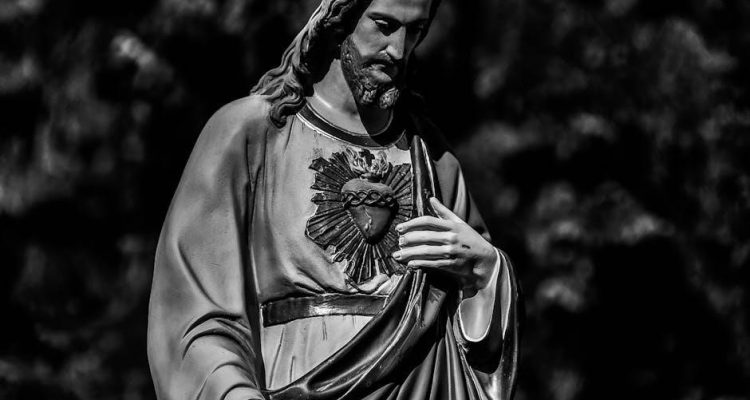The Litany of the Sacred Heart of Jesus is a devotional prayer honoring Christ’s love and mercy. It consists of 33 supplications, praising His divine heart as a symbol of God’s tenderness and redemption. Widely used in Catholic devotion, it is often recited for personal reflection, communal worship, and reparation. Available in PDF format, it remains a timeless tool for deepening one’s spiritual connection to Jesus.
Overview of the Litany
The Litany of the Sacred Heart of Jesus is a traditional Catholic prayer composed of 33 supplications, each invoking the Sacred Heart with unique titles and attributes. Approved by Pope Leo XIII in 1899, it synthesizes earlier devotionals, emphasizing Christ’s divine and human heart as a symbol of God’s boundless love and mercy. The litany is structured with invocations and responses, making it accessible for both personal reflection and communal recitation. Its themes of reparation, adoration, and intercession reflect its purpose to honor Jesus’ sacrificial love. Widely available in PDF format, it remains a popular resource for spiritual devotion and prayer life.
Significance of the Sacred Heart of Jesus in Catholic Devotion
The Sacred Heart of Jesus symbolizes God’s boundless love and mercy, representing Christ’s divine and human heart, pierced for humanity’s redemption. It embodies His passion, sacrifice, and tender affection for sinners, serving as a powerful devotion in Catholic spirituality. The Sacred Heart is often associated with themes of reparation and divine mercy, inspiring believers to reflect on Christ’s selfless love. This devotion is deeply connected to the Eucharist and the Holy Spirit, who formed Jesus’ heart in the Virgin Mary’s womb. The Litany of the Sacred Heart is a key expression of this devotion, helping faithful honor and connect with Jesus’ loving heart through prayer and adoration.
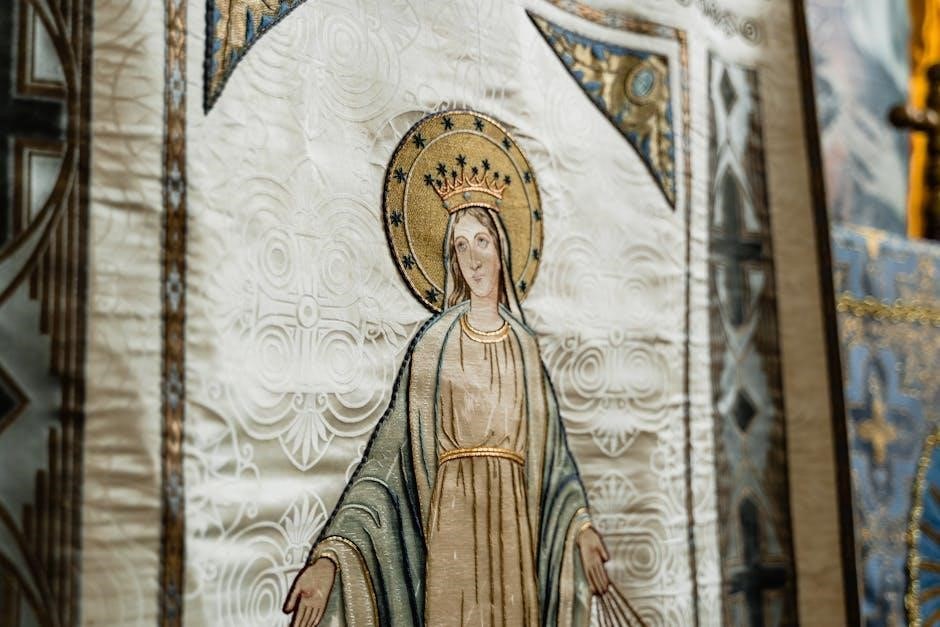
History of the Litany of the Sacred Heart of Jesus
The Litany of the Sacred Heart originated in 17th-century France, evolving from earlier devotional practices. It was officially approved by Pope Leo XIII in 1899 for public use.
Origins and Development
The Litany of the Sacred Heart of Jesus traces its origins to 17th-century France, emerging from the devotion popularized by Saint Margaret Mary Alacoque. It synthesized earlier litanies, becoming a structured prayer with 33 supplications. These invocations reflect Jesus’ divine and human heart, emphasizing love, mercy, and sacrifice. The litany gained prominence in Marseille during the 18th century and spread globally, becoming a cornerstone of Catholic devotion. Its development mirrors the evolving understanding of Christ’s heart as a symbol of divine love. Available in PDF, it remains a vital tool for modern spiritual practices, blending tradition with accessibility.
Approval by Pope Leo XIII in 1899
In 1899, Pope Leo XIII officially approved the Litany of the Sacred Heart of Jesus for public use, recognizing its deep theological significance. This endorsement elevated its status, making it a universal Catholic devotion. The Pope’s approval marked a pivotal moment, encouraging its recitation worldwide. The litany, now sanctioned by the Church, became a standard prayer in parishes and homes, fostering devotion to Christ’s Sacred Heart. Its official recognition ensured its longevity, making it accessible in formats like PDF for modern faithful to deepen their spiritual connection and offer reparation through its timeless invocations.
Evolution of the Litany Over the Centuries
The Litany of the Sacred Heart of Jesus evolved from earlier devotions to the Sacred Heart, blending traditions and prayers from the 17th century onward. Initially, it was compiled from various litanies, reflecting the deepening understanding of Christ’s heart as a symbol of divine love. Over time, its structure and supplications were refined, emphasizing themes of mercy, reparation, and adoration. By the 19th century, it had become a standardized prayer, officially approved in 1899; Today, it remains a vibrant devotion, adapted into formats like PDF for modern accessibility, ensuring its timeless relevance in Catholic spirituality and communal worship.

Structure of the Litany of the Sacred Heart of Jesus
The litany includes 33 supplications, invocations, and praises, beginning with mercy requests and progressing through Christ’s divine attributes. Available in PDF, it offers a structured devotion.
Components of the Litany
The litany comprises 33 invocations, each addressing the Sacred Heart with titles reflecting its divine and human qualities. These include “Holy Temple of God,” “Tabernacle of the Most High,” and “House of God and Gate of Heaven.” Each invocation is followed by a supplication, such as “have mercy on us,” creating a rhythmic and meditative prayer experience. The structure begins with appeals for mercy, transitions into adoration of Christ’s heart, and concludes with petitions for grace and salvation. This systematic approach allows devotees to deeply contemplate the Heart of Jesus, fostering devotion and reparation. Available in PDF, it enhances accessibility for personal and communal use.
Invocation and Supplications
The Litany of the Sacred Heart of Jesus is structured with 33 invocations, each invoking the Sacred Heart using titles such as “Holy Temple of God” and “Tabernacle of the Most High.” Each invocation is followed by a supplication like “have mercy on us,” creating a meditative rhythm. This structure invites devotees to reflect on Christ’s divine love and humanity, offering reparation for sins. The supplications emphasize mercy and forgiveness, fostering a deeper connection with Jesus. Available in PDF, this litany is a powerful tool for personal and communal devotion, encouraging spiritual reflection and penance in both private and shared prayer settings.
Comparison with Other Catholic Litanies
The Litany of the Sacred Heart of Jesus shares a similar structure with other Catholic litanies, such as the Litany of Loreto, but its focus is uniquely centered on the Sacred Heart. Unlike general litanies, it emphasizes the heart of Jesus as a symbol of divine love and mercy. While most litanies invoke saints or divine attributes, this one directly addresses Christ’s heart, highlighting themes of reparation and devotion. Its 33 supplications, like “Heart of Jesus, formed by the Holy Spirit,” distinguish it from other litanies, offering a profound meditation on Christ’s love and humanity. Available in PDF, it remains a distinctive and cherished devotional tool.
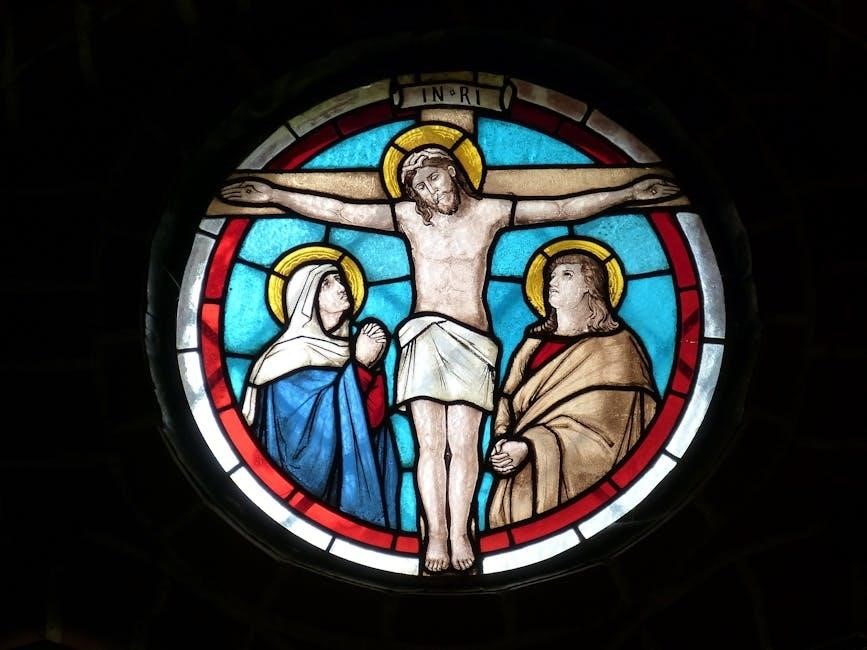
Theological Significance of the Litany
The Litany of the Sacred Heart of Jesus reflects the heart of Christ as a symbol of divine love and redemption. It emphasizes themes of mercy, reparation, and the Holy Spirit’s role in forming Christ’s heart, embodying God’s infinite tenderness. This devotion, rooted in Catholic theology, invites believers to contemplate the Trinitarian relationship and the heart of Jesus as the source of salvation and divine love.
The Sacred Heart as a Symbol of God’s Love
The Sacred Heart of Jesus, depicted as a pierced and flaming heart, symbolizes God’s boundless love and mercy. It embodies the divine and human love of Christ, emphasizing His tenderness toward sinners. The litany’s supplications, such as “Heart of Jesus, formed by the Holy Spirit in the womb of the Virgin Mother,” highlight the heart as a vessel of divine attributes. This symbol represents God’s infinite love, forgiveness, and redemption, inviting believers to reflect on Christ’s passion and mercy. The Sacred Heart serves as a powerful reminder of God’s enduring love, making it a central devotion in Catholic spirituality and the litany’s core theme.
Themes of Mercy and Reparation
The Litany of the Sacred Heart of Jesus emphasizes themes of mercy and reparation, reflecting Christ’s compassion and humanity’s need for forgiveness. Through supplications like “Heart of Jesus, source of mercy and justice,” the litany underscores God’s loving forgiveness. It also invites believers to make amends for sins committed against Christ’s love, fostering a spirit of reparation. This devotion is particularly relevant in times of crisis, as seen during the COVID-19 pandemic, when Archbishop Gomez urged its recitation for divine intervention. The litany’s focus on mercy and reparation highlights the enduring need for spiritual healing and reconciliation in a world seeking God’s grace.
The Role of the Holy Spirit in the Formation of the Sacred Heart
The Holy Spirit played a pivotal role in forming the Sacred Heart of Jesus, as expressed in the litany. The invocation “Heart of Jesus, formed by the Holy Spirit in the womb of the Virgin Mother” highlights this divine action. The Holy Spirit shaped Jesus’ heart as a vessel of divine love, uniting human and divine qualities. This formation underscores the Holy Spirit’s role in incarnating God’s love, making the Sacred Heart a symbol of divine tenderness and compassion. The litany thus invites believers to reflect on the Holy Spirit’s work in forming Christ’s heart, embodying mercy and redemption for humanity.
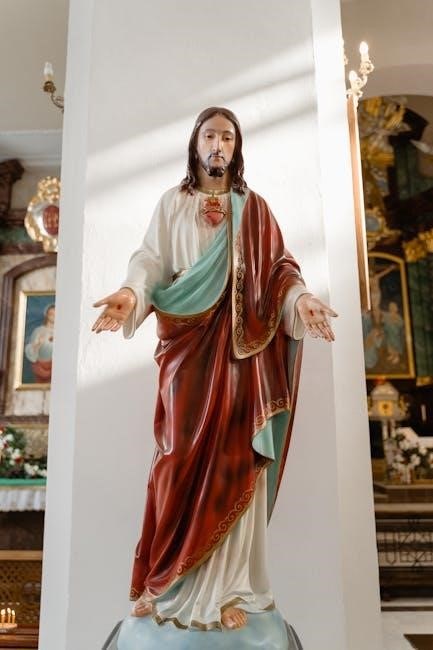
Prayer and Devotion
The Litany of the Sacred Heart of Jesus is a powerful prayer for meditating on Christ’s love and mercy, fostering devotion through personal reflection and communal recitation.
How to Pray the Litany of the Sacred Heart
To pray the Litany of the Sacred Heart of Jesus, begin with a moment of silence and preparation. Start with the invocation, “Lord, have mercy,” and alternate between the leader and congregation or family. Each supplication, such as “Heart of Jesus, formed by the Holy Spirit,” invites reflection on Christ’s divine and human heart. Pray slowly and thoughtfully, focusing on the themes of mercy, love, and reparation. The litany can be recited individually or communally, making it a versatile prayer for personal devotion or parish gatherings. Its rhythmic structure fosters unity and deepens one’s connection to Christ’s boundless love.
Using the Litany for Personal Reflection
The Litany of the Sacred Heart of Jesus is a profound tool for personal reflection, inviting individuals to meditate on Christ’s divine love and mercy. Each invocation, such as “Heart of Jesus, formed by the Holy Spirit,” encourages introspection and connection with God’s tenderness. To use it for reflection, recite the litany slowly, pausing after each line to contemplate its meaning. This practice fosters gratitude, repentance, and a deeper understanding of Christ’s sacrifice. The PDF format makes it accessible for private devotion, allowing individuals to pray anytime, even in solitude, and seek spiritual renewal through the Sacred Heart’s boundless love and compassion.
Communal Recitation in Parishes and Communities
The Litany of the Sacred Heart of Jesus is often recited collectively in parishes and communities, fostering unity and devotion among the faithful. This communal practice strengthens spiritual bonds and amplifies the prayer’s impact. Many parishes incorporate the litany into Eucharistic adoration or special devotional services, particularly on the Feast Day of the Sacred Heart. Archbishop Gomez has encouraged its recitation in response to cultural challenges, emphasizing its power as a prayer of reparation. The PDF format makes it easy for communities to access and share, ensuring widespread participation in this timeless expression of faith and love for Christ’s Sacred Heart.
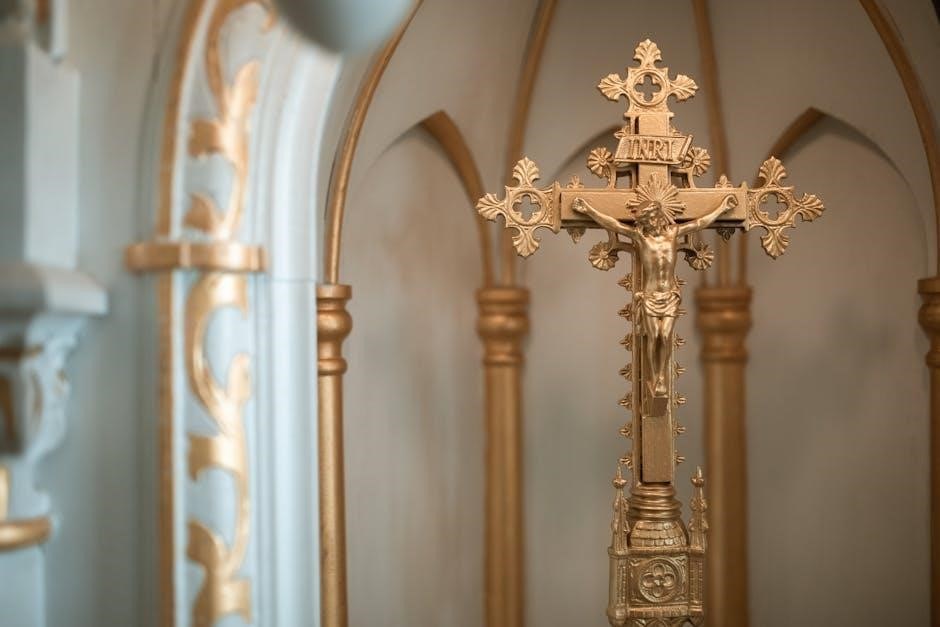
Cultural and Liturgical Impact
The Litany of the Sacred Heart of Jesus has inspired art, music, and devotion worldwide. Its recitation during the COVID-19 pandemic highlighted its enduring relevance in worship and culture. The PDF format ensures accessibility, fostering its use in liturgical and communal settings, bridging tradition with modern spirituality.
The Litany in Art and Music
The Litany of the Sacred Heart of Jesus has deeply influenced Catholic art and music, inspiring compositions that reflect its spiritual depth. Canticles and choral works, such as those for solo voices, have been composed to accompany its recitation, enriching liturgical celebrations. In music, the litany’s supplications are often set to melodies that evoke devotion and contemplation. Similarly, its themes of divine love and mercy have been depicted in sacred art, with the Sacred Heart symbol becoming a central motif in Catholic iconography. The litany’s beauty and reverence continue to inspire artists and musicians, bridging faith and culture. Its availability in PDF has further expanded its reach, fostering both personal and communal devotion.
Feast Day Celebrations of the Sacred Heart
The Feast of the Sacred Heart, celebrated annually on June 16, is a time of profound devotion. Catholics worldwide honor Christ’s love through liturgies, processions, and recitation of the Litany of the Sacred Heart. Parishes often organize special Masses and Eucharistic adoration, emphasizing themes of mercy and reparation. The litany, available in PDF, is frequently used during these celebrations to deepen spiritual connection. Archbishop Gomez has encouraged its recitation for contemporary issues, such as the COVID-19 pandemic. This feast fosters communal and personal devotion, reflecting the enduring significance of the Sacred Heart in Catholic spirituality and practice. Its traditions continue to inspire faith and unity among believers globally.
Role of the Litany in Eucharistic Adoration
The Litany of the Sacred Heart of Jesus plays a vital role in Eucharistic adoration, deepening devotion to Christ’s real presence. Often recited during adoration, it serves as a powerful prayer of reparation and intercession. Its supplications, such as “Heart of Jesus, tabernacle of the Most High,” reflect the Eucharistic mystery. Available in PDF, the litany is frequently used in adoration chambers worldwide, fostering a spirit of atonement and love. Archbishop Gomez has emphasized its use during the pandemic, illustrating its adaptability in addressing contemporary needs while maintaining traditional reverence for the Sacred Heart. This practice strengthens the bond between the faithful and the Eucharistic Lord, enriching spiritual life and community worship.
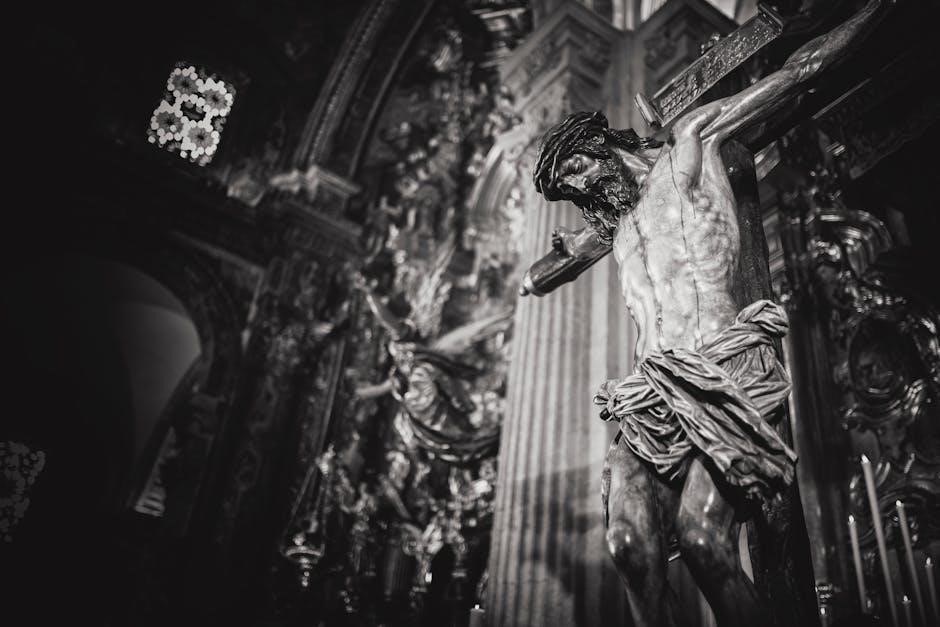
Modern Relevance of the Litany
The Litany of the Sacred Heart of Jesus remains highly relevant today, offering solace amidst contemporary challenges like the COVID-19 pandemic. Archbishop Gomez encouraged its use for global healing, demonstrating its enduring adaptability. Available in PDF, it continues to inspire Catholics worldwide to seek mercy and reparation, bridging traditional devotion with modern spiritual needs.
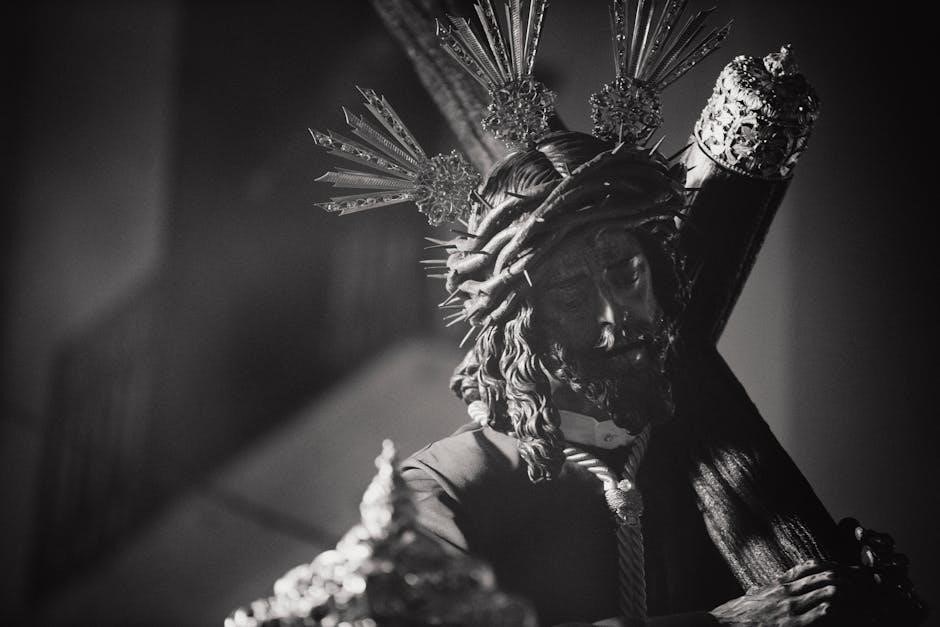
Praying for Contemporary Issues
The Litany of the Sacred Heart of Jesus is a powerful tool for addressing modern challenges. During the COVID-19 pandemic, Archbishop Gomez encouraged its recitation for global healing, highlighting its relevance in crises. It is also used to pray for issues like social injustice, environmental concerns, and personal struggles. The litany’s themes of mercy and reparation resonate deeply, offering comfort and hope. By invoking the Sacred Heart, Catholics seek divine intervention and strength to navigate contemporary problems. Its adaptability makes it a vital prayer resource for today’s world, fostering spiritual renewal and unity in the face of adversity.
Use of the Litany During the COVID-19 Pandemic
During the COVID-19 pandemic, the Litany of the Sacred Heart of Jesus became a source of comfort and hope. Archbishop José Gomez called for its recitation on Good Friday 2020, urging Catholics to pray for an end to the pandemic. The litany’s themes of mercy and reparation resonated deeply as people sought divine intervention. Many parishes and individuals used the PDF version to pray remotely, fostering a sense of unity despite physical distancing. This ancient devotion found new relevance, offering solace and spiritual strength to millions affected by the crisis, embodying the enduring power of faith in times of need.
Archbishop Gomez’s Call to Prayer
Archbishop José Gomez called for nationwide prayer during the COVID-19 pandemic, urging Catholics to recite the Litany of the Sacred Heart of Jesus on Good Friday 2020. He emphasized the litany’s power to seek divine mercy and healing. The archbishop’s initiative highlighted the timeless relevance of this devotion, encouraging believers to unite spiritually amid global crisis. The PDF version of the litany was widely shared, facilitating remote participation. Archbishop Gomez’s call underscored the importance of prayer in times of suffering, inspiring hope and fostering a sense of solidarity among the faithful. His leadership reminded the Church of the enduring comfort found in devotion to the Sacred Heart.

Practical Resources
The Litany of the Sacred Heart of Jesus is widely available in PDF format, enabling easy access for personal and communal devotion. Guides and instructional materials accompany the litany, helping leaders facilitate group recitation. Regular use of the litany in daily prayer fosters spiritual growth and deepens one’s connection to Christ’s divine love, making it an invaluable resource for Catholics seeking to enrich their faith journey.
Accessing the Litany in PDF Format
The Litany of the Sacred Heart of Jesus is readily available in PDF format online, offering convenience for personal and communal devotion. Official Catholic websites, such as those of the Archdiocese of Los Angeles and EWTN, provide downloadable versions. These PDFs are designed for easy printing and sharing, ensuring widespread accessibility. They often include the full text of the litany, making it simple to follow during prayer. Additionally, the PDF format preserves the structure and dignity of the litany, allowing devotees to use it in both private and public worship settings. This accessibility has made the litany a popular choice for spiritual reflection and communal recitation worldwide.
Guides for Leading the Litany

Leading the Litany of the Sacred Heart of Jesus requires a reverent and organized approach. Begin by reviewing the PDF version to understand the structure and flow. Assign a leader to guide the congregation, ensuring a steady rhythm and clear pronunciation. Encourage participants to follow along with the PDF, fostering active engagement. Emphasize the importance of pauses between supplications for reflection. Leaders may also provide brief explanations of key invocations to deepen devotion. Proper preparation and a prayerful demeanor will help create a meaningful experience for all participants, fostering unity and spiritual connection.
Benefits of Using the Litany in Daily Prayer Life
Incorporating the Litany of the Sacred Heart of Jesus into daily prayer offers profound spiritual benefits. It fosters a deeper connection with Christ’s divine love and mercy, encouraging personal reflection and devotion. The structured format of the litany provides clarity and focus, helping individuals stay engaged in prayer. Regular recitation cultivates gratitude, humility, and compassion, aligning one’s heart with Christ’s. It also serves as a powerful tool for reparation, offering consolation to Jesus for the sins of the world. Available in PDF format, the litany is easily accessible, making it a convenient and meaningful addition to daily prayer routines, enriching both personal and communal worship experiences.
The Litany of the Sacred Heart of Jesus remains a profound devotional tool, fostering mercy, reparation, and spiritual enrichment. Its timeless relevance invites continuous prayer and reflection, deepening faith and connection to Christ’s divine love.
Final Reflections on the Litany’s Importance
The Litany of the Sacred Heart of Jesus holds profound significance as a devotional prayer, offering a deep meditation on Christ’s love and mercy. Its 33 supplications, approved by Pope Leo XIII in 1899, provide a structured yet personal way to reflect on Jesus’ divine and human heart, emphasizing themes of reparation and divine love. Available in PDF formats, it serves as an accessible tool for both individual and communal prayer, fostering spiritual growth and a closer connection to Christ’s sacrificial love. This litany remains a timeless resource for Catholics seeking to honor and deepen their devotion to the Sacred Heart.
Encouragement to Incorporate the Litany into Spiritual Practices
Incorporating the Litany of the Sacred Heart of Jesus into daily spiritual practices enriches one’s faith journey. Reciting it regularly fosters a deeper connection to Christ’s divine love and mercy. Its structured format, available in PDF, makes it easy to use for personal reflection or communal prayer. During challenging times, such as the COVID-19 pandemic, the litany has served as a powerful tool for seeking solace and unity. By embracing this timeless devotion, individuals can strengthen their spiritual life, find comfort in Christ’s heart, and grow in holiness. Make it a part of your prayer routine to experience its transformative power.
